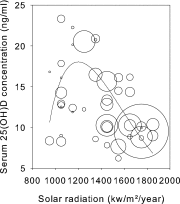Genetic, Environmental, and Disease-Associated Correlates of Vitamin D Status in Children with CKD
- PMID: 27313313
- PMCID: PMC4934841
- DOI: 10.2215/CJN.10210915
Genetic, Environmental, and Disease-Associated Correlates of Vitamin D Status in Children with CKD
Abstract
Background and objectives: Vitamin D deficiency is endemic in children with CKD. We sought to investigate the association of genetic disposition, environmental factors, vitamin D supplementation, and renal function on vitamin D status in children with CKD.
Design, setting, participants, & measurements: Serum 25-hydroxy-vitamin D, 1,25-dihydroxy-vitamin D, and 24,25-dihydroxy-vitamin D concentrations were measured cross-sectionally in 500 children from 12 European countries with CKD stages 3-5. All patients were participants of the Cardiovascular Comorbidity in Children with Chronic Kidney Disease Study, had CKD stage 3-5, and were age 6-18 years old. Patients were genotyped for single-nucleotide polymorphisms in the genes encoding 25-hydroxylase, vitamin D binding protein, 7-dehydrocholesterol reductase, and 24-hydroxylase. Associations of genetic status, season, local solar radiation, oral vitamin D supplementation, and disease-associated factors with vitamin D status were assessed.
Results: Two thirds of patients were vitamin D deficient (25-hydroxy-vitamin D <16 ng/ml). 25-Hydroxy-vitamin D concentrations varied with season and were twofold higher in vitamin D-supplemented patients (21.6 [14.1] versus 10.4 [10.1] ng/ml; P<0.001). Glomerulopathy, albuminuria, and girls were associated with lower 25-hydroxy-vitamin D levels. 24,25-dihydroxy-vitamin D levels were closely correlated with 25-hydroxy-vitamin D and 1,25-dihydroxy-vitamin D (r=0.87 and r=0.55; both P<0.001). 24,25-dihydroxy-vitamin D concentrations were higher with higher c-terminal fibroblast growth factor 23 and inversely correlated with intact parathyroid hormone. Whereas 25-hydroxy-vitamin D levels were independent of renal function, 24,25-dihydroxy-vitamin D levels were lower with lower eGFR. Vitamin D deficiency was more prevalent in Turkey than in other European regions independent of supplementation status and disease-related factors. Single-nucleotide polymorphisms in the vitamin D binding protein gene were independently associated with lower 25-hydroxy-vitamin D and higher 24,25-dihydroxy-vitamin D.
Conclusions: Disease-related factors and vitamin D supplementation are the main correlates of vitamin D status in children with CKD. Variants in the vitamin D binding protein showed weak associations with the vitamin D status.
Keywords: 25-hydroxyvitamin D; Child; Humans; Polymorphism, Single Nucleotide; Renal Insufficiency, Chronic; Vitamin D; albuminuria; chronic kidney disease; vitamin D deficiency; vitamin d supplementation.
Copyright © 2016 by the American Society of Nephrology.
Figures


References
-
- Holick MF: Vitamin D deficiency. N Engl J Med 357: 266–281, 2007 - PubMed
-
- Bischoff-Ferrari H: Health effects of vitamin D. Dermatol Ther (Heidelb) 23: 23–30, 2010 - PubMed
-
- Ovesen L, Andersen R, Jakobsen J: Geographical differences in vitamin D status, with particular reference to European countries. Proc Nutr Soc 62: 813–821, 2003 - PubMed
-
- Gordon CM, DePeter KC, Feldman HA, Grace E, Emans SJ: Prevalence of vitamin D deficiency among healthy adolescents. Arch Pediatr Adolesc Med 158: 531–537, 2004 - PubMed
-
- Weng FL, Shults J, Leonard MB, Stallings VA, Zemel BS: Risk factors for low serum 25-hydroxyvitamin D concentrations in otherwise healthy children and adolescents. Am J Clin Nutr 86: 150–158, 2007 - PubMed
MeSH terms
Substances
Grants and funding
LinkOut - more resources
Full Text Sources
Other Literature Sources
Medical
Research Materials
Miscellaneous

